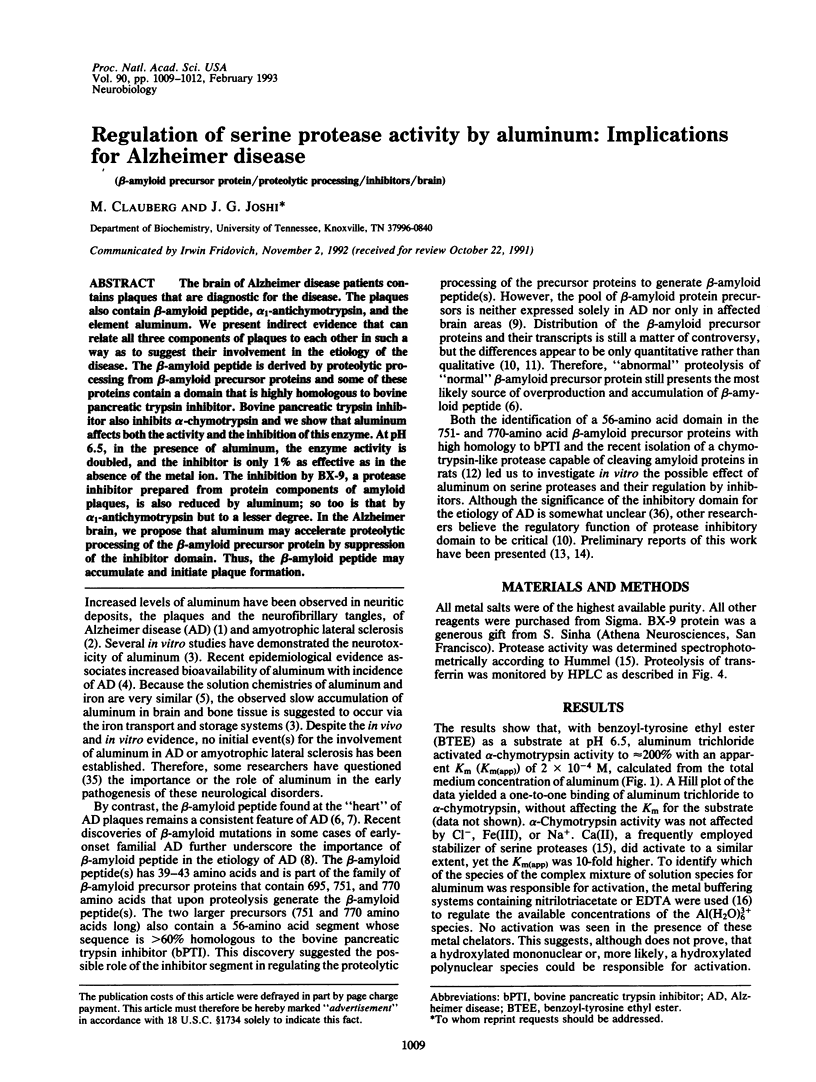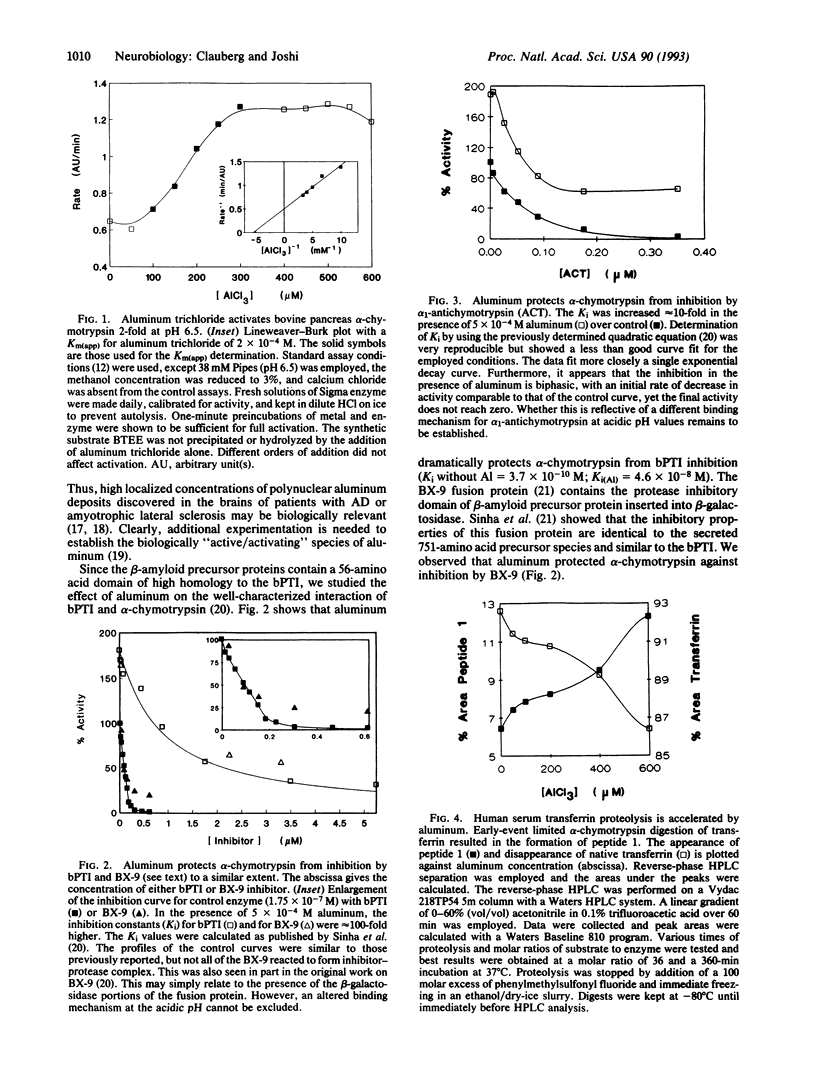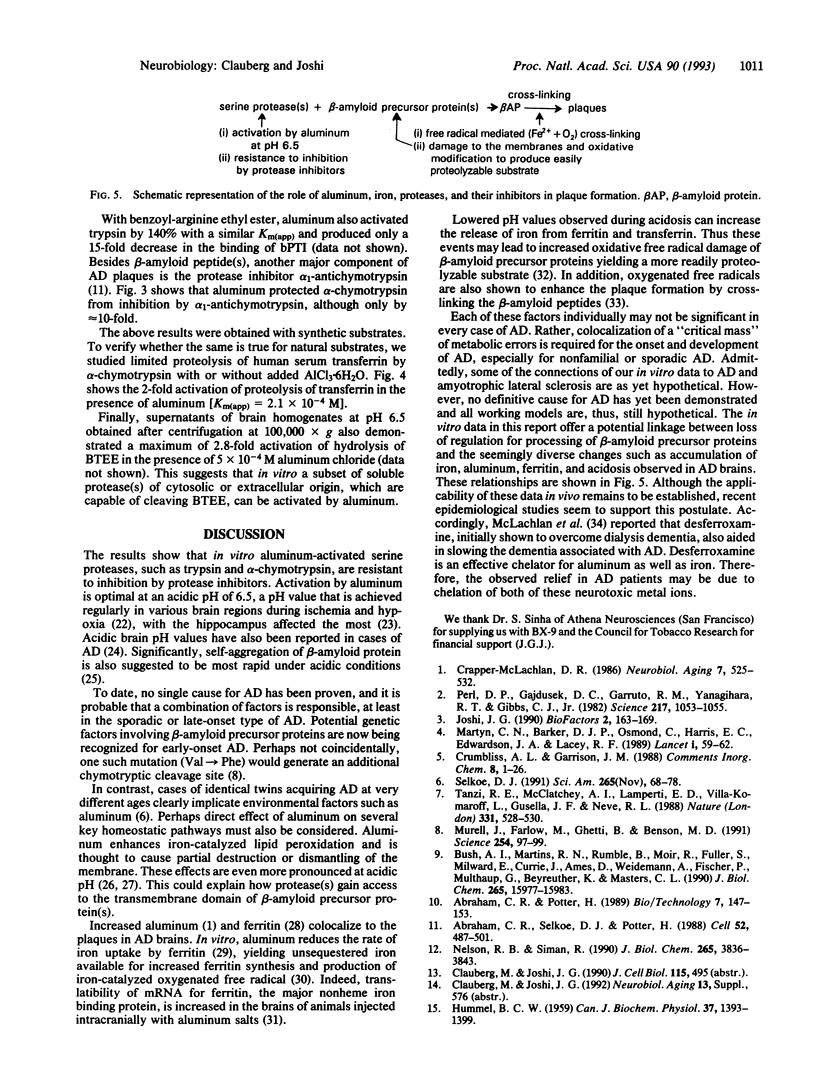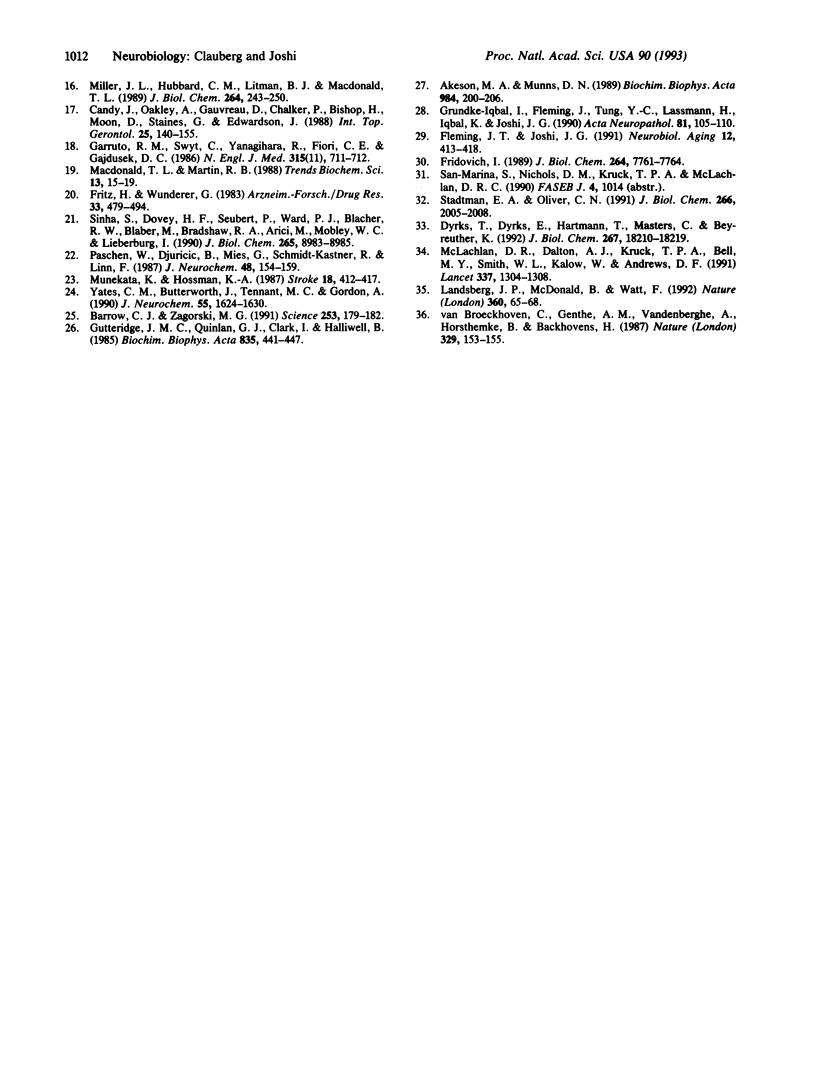Abstract
The brain of Alzheimer disease patients contains plaques that are diagnostic for the disease. The plaques also contain beta-amyloid peptide, alpha 1-antichymotrypsin, and the element aluminum. We present indirect evidence that can relate all three components of plaques to each other in such a way as to suggest their involvement in the etiology of the disease. The beta-amyloid peptide is derived by proteolytic processing from beta-amyloid precursor proteins and some of these proteins contain a domain that is highly homologous to bovine pancreatic trypsin inhibitor. Bovine pancreatic trypsin inhibitor also inhibits alpha-chymotrypsin and we show that aluminum affects both the activity and the inhibition of this enzyme. At pH 6.5, in the presence of aluminum, the enzyme activity is doubled, and the inhibitor is only 1% as effective as in the absence of the metal ion. The inhibition by BX-9, a protease inhibitor prepared from protein components of amyloid plaques, is also reduced by aluminum; so too is that by alpha 1-antichymotrypsin but to a lesser degree. In the Alzheimer brain, we propose that aluminum may accelerate proteolytic processing of the beta-amyloid precursor protein by suppression of the inhibitor domain. Thus, the beta-amyloid peptide may accumulate and initiate plaque formation.
Full text
PDF



Selected References
These references are in PubMed. This may not be the complete list of references from this article.
- Abraham C. R., Selkoe D. J., Potter H. Immunochemical identification of the serine protease inhibitor alpha 1-antichymotrypsin in the brain amyloid deposits of Alzheimer's disease. Cell. 1988 Feb 26;52(4):487–501. doi: 10.1016/0092-8674(88)90462-x. [DOI] [PubMed] [Google Scholar]
- Akeson M. A., Munns D. N. Lipid bilayer permeation by neutral aluminum citrate and by three alpha-hydroxy carboxylic acids. Biochim Biophys Acta. 1989 Sep 4;984(2):200–206. doi: 10.1016/0005-2736(89)90217-4. [DOI] [PubMed] [Google Scholar]
- Barrow C. J., Zagorski M. G. Solution structures of beta peptide and its constituent fragments: relation to amyloid deposition. Science. 1991 Jul 12;253(5016):179–182. doi: 10.1126/science.1853202. [DOI] [PubMed] [Google Scholar]
- Bush A. I., Martins R. N., Rumble B., Moir R., Fuller S., Milward E., Currie J., Ames D., Weidemann A., Fischer P. The amyloid precursor protein of Alzheimer's disease is released by human platelets. J Biol Chem. 1990 Sep 15;265(26):15977–15983. [PubMed] [Google Scholar]
- Crapper McLachlan D. R., Dalton A. J., Kruck T. P., Bell M. Y., Smith W. L., Kalow W., Andrews D. F. Intramuscular desferrioxamine in patients with Alzheimer's disease. Lancet. 1991 Jun 1;337(8753):1304–1308. doi: 10.1016/0140-6736(91)92978-b. [DOI] [PubMed] [Google Scholar]
- Dyrks T., Dyrks E., Hartmann T., Masters C., Beyreuther K. Amyloidogenicity of beta A4 and beta A4-bearing amyloid protein precursor fragments by metal-catalyzed oxidation. J Biol Chem. 1992 Sep 5;267(25):18210–18217. [PubMed] [Google Scholar]
- Fleming J. T., Joshi J. G. Ferritin: the role of aluminum in ferritin function. Neurobiol Aging. 1991 Sep-Oct;12(5):413–418. doi: 10.1016/0197-4580(91)90066-s. [DOI] [PubMed] [Google Scholar]
- Fridovich I. Superoxide dismutases. An adaptation to a paramagnetic gas. J Biol Chem. 1989 May 15;264(14):7761–7764. [PubMed] [Google Scholar]
- Fritz H., Wunderer G. Biochemistry and applications of aprotinin, the kallikrein inhibitor from bovine organs. Arzneimittelforschung. 1983;33(4):479–494. [PubMed] [Google Scholar]
- Garruto R. M., Swyt C., Yanagihara R., Fiori C. E., Gajdusek D. C. Intraneuronal co-localization of silicon with calcium and aluminum in amyotrophic lateral sclerosis and parkinsonism with dementia of Guam. N Engl J Med. 1986 Sep 11;315(11):711–712. doi: 10.1056/NEJM198609113151115. [DOI] [PubMed] [Google Scholar]
- Grundke-Iqbal I., Fleming J., Tung Y. C., Lassmann H., Iqbal K., Joshi J. G. Ferritin is a component of the neuritic (senile) plaque in Alzheimer dementia. Acta Neuropathol. 1990;81(2):105–110. doi: 10.1007/BF00334497. [DOI] [PubMed] [Google Scholar]
- Gutteridge J. M., Quinlan G. J., Clark I., Halliwell B. Aluminium salts accelerate peroxidation of membrane lipids stimulated by iron salts. Biochim Biophys Acta. 1985 Jul 31;835(3):441–447. doi: 10.1016/0005-2760(85)90113-4. [DOI] [PubMed] [Google Scholar]
- HUMMEL B. C. A modified spectrophotometric determination of chymotrypsin, trypsin, and thrombin. Can J Biochem Physiol. 1959 Dec;37:1393–1399. [PubMed] [Google Scholar]
- Joshi J. G. Aluminum, a neurotoxin which affects diverse metabolic reactions. Biofactors. 1990 Jul;2(3):163–169. [PubMed] [Google Scholar]
- Landsberg J. P., McDonald B., Watt F. Absence of aluminium in neuritic plaque cores in Alzheimer's disease. Nature. 1992 Nov 5;360(6399):65–68. doi: 10.1038/360065a0. [DOI] [PubMed] [Google Scholar]
- Macdonald T. L., Martin R. B. Aluminum ion in biological systems. Trends Biochem Sci. 1988 Jan;13(1):15–19. doi: 10.1016/0968-0004(88)90012-6. [DOI] [PubMed] [Google Scholar]
- Martyn C. N., Barker D. J., Osmond C., Harris E. C., Edwardson J. A., Lacey R. F. Geographical relation between Alzheimer's disease and aluminum in drinking water. Lancet. 1989 Jan 14;1(8629):59–62. [PubMed] [Google Scholar]
- McLachlan D. R. Aluminum and Alzheimer's disease. Neurobiol Aging. 1986 Nov-Dec;7(6):525–532. doi: 10.1016/0197-4580(86)90102-8. [DOI] [PubMed] [Google Scholar]
- Miller J. L., Hubbard C. M., Litman B. J., Macdonald T. L. Inhibition of transducin activation and guanosine triphosphatase activity by aluminum ion. J Biol Chem. 1989 Jan 5;264(1):243–250. [PubMed] [Google Scholar]
- Munekata K., Hossmann K. A. Effect of 5-minute ischemia on regional pH and energy state of the gerbil brain: relation to selective vulnerability of the hippocampus. Stroke. 1987 Mar-Apr;18(2):412–417. doi: 10.1161/01.str.18.2.412. [DOI] [PubMed] [Google Scholar]
- Murrell J., Farlow M., Ghetti B., Benson M. D. A mutation in the amyloid precursor protein associated with hereditary Alzheimer's disease. Science. 1991 Oct 4;254(5028):97–99. doi: 10.1126/science.1925564. [DOI] [PubMed] [Google Scholar]
- Nelson R. B., Siman R. Clipsin, a chymotrypsin-like protease in rat brain which is irreversibly inhibited by alpha-1-antichymotrypsin. J Biol Chem. 1990 Mar 5;265(7):3836–3843. [PubMed] [Google Scholar]
- Paschen W., Djuricic B., Mies G., Schmidt-Kastner R., Linn F. Lactate and pH in the brain: association and dissociation in different pathophysiological states. J Neurochem. 1987 Jan;48(1):154–159. doi: 10.1111/j.1471-4159.1987.tb13140.x. [DOI] [PubMed] [Google Scholar]
- Perl D. P., Gajdusek D. C., Garruto R. M., Yanagihara R. T., Gibbs C. J. Intraneuronal aluminum accumulation in amyotrophic lateral sclerosis and Parkinsonism-dementia of Guam. Science. 1982 Sep 10;217(4564):1053–1055. doi: 10.1126/science.7112111. [DOI] [PubMed] [Google Scholar]
- Selkoe D. J. Amyloid protein and Alzheimer's disease. Sci Am. 1991 Nov;265(5):68-71, 74-6, 78. doi: 10.1038/scientificamerican1191-68. [DOI] [PubMed] [Google Scholar]
- Sinha S., Dovey H. F., Seubert P., Ward P. J., Blacher R. W., Blaber M., Bradshaw R. A., Arici M., Mobley W. C., Lieberburg I. The protease inhibitory properties of the Alzheimer's beta-amyloid precursor protein. J Biol Chem. 1990 Jun 5;265(16):8983–8985. [PubMed] [Google Scholar]
- Stadtman E. R., Oliver C. N. Metal-catalyzed oxidation of proteins. Physiological consequences. J Biol Chem. 1991 Feb 5;266(4):2005–2008. [PubMed] [Google Scholar]
- Tanzi R. E., McClatchey A. I., Lamperti E. D., Villa-Komaroff L., Gusella J. F., Neve R. L. Protease inhibitor domain encoded by an amyloid protein precursor mRNA associated with Alzheimer's disease. Nature. 1988 Feb 11;331(6156):528–530. doi: 10.1038/331528a0. [DOI] [PubMed] [Google Scholar]
- Van Broeckhoven C., Genthe A. M., Vandenberghe A., Horsthemke B., Backhovens H., Raeymaekers P., Van Hul W., Wehnert A., Gheuens J., Cras P. Failure of familial Alzheimer's disease to segregate with the A4-amyloid gene in several European families. Nature. 1987 Sep 10;329(6135):153–155. doi: 10.1038/329153a0. [DOI] [PubMed] [Google Scholar]
- Yates C. M., Butterworth J., Tennant M. C., Gordon A. Enzyme activities in relation to pH and lactate in postmortem brain in Alzheimer-type and other dementias. J Neurochem. 1990 Nov;55(5):1624–1630. doi: 10.1111/j.1471-4159.1990.tb04948.x. [DOI] [PubMed] [Google Scholar]


